Civil War Historical Items and Other
Factory Engraved Inscribed Colt Navy Revolver 14th Michigan Infantry.

21-09-05 FINE GUSTAVE YOUNG DELUXE ENGRAVED COLT MODEL 1851 NAVY REVOLVER. SN 99672. Cal. 36. Fine engraved 4th Model 51 Navy with 7-1/2″ oct bbl, dovetailed front sight and 1-line Hartford address. It has silver plated trigger guard & back strap around a beautiful deluxe burl wood grip. Revolver is beautifully engraved in Gustave Youngs deluxe patterns with full coverage foliate arabesque patterns on frame & recoil shields with some scrolls terminating in flower blossoms. Barrel lug and rammer pivot are engraved to match. Engraving extends over top two side flats with a border pattern around the Hartford barrel legend. Top of back strap has the iconic Gustave Young fan pattern with matching foliate arabesque patterns near the top of back the strap, at the heel, on butt strap and trigger guard. Left side of frame has – COLTS PATENT – hand engraved in an artistic cloud-like panel well known as the Gustave Young form. Hammer is matching.
The back strap is also engraved/inscribed with the Wolverine State owner’s name. – Lt. Fred’ Banks – This is Lieutenant Frederick Banks of the 14th Michigan Volunteer Infantry. Frederick Banks lived in Pontiac, Michigan and was 23 years old when he joined the Union Army. He enlisted on 2/13/1862 at Pontiac as a Sergeant and was mustered into Co. I 14th Michigan Infantry. He was listed as: * Missing 4/30/1864 (place not stated) . During his service he was promoted to Sergeant Major, and then to 2nd Lieutenant on June 20th 1862. He was born in 1840 and died 6/12/1891. He is buried in Ridgelawn Cemetery, Oxford, Oakland Co., MI. After the War he lived in Oakland County, MI.
Here is a history of the regiment. Organized at Ypsilanti and Detroit, Mich., January 7 to February 18, 1862. Mustered in February 13, 1862. Left State for St. Louis, Mo., April 17, thence moved to Pittsburg Landing, Tenn. Attached to 2nd Brigade, 1st Division, Army of Mississippi, to September, 1862. 2nd Brigade, 13th Division, Army of the Ohio, to November, 1862. 1st Brigade, 4th Division, Center 14th Army Corps, Army of the Cumberland, to January, 1863. 1st Brigade, 4th Division, 14th Army Corps, Army of the Cumberland, to June, 1863. 1st Brigade, 2nd Division, Reserve Corps, Army of the Cumberland, to October, 1863. 1st Brigade, 2nd Division, 14th Army Corps, Army of the Cumberland, to December, 1863. Columbia, Tenn., Dept. of the Cumberland, to May, 1864. 1st Brigade, 2nd Division, 14th Army Corps, Army of the Cumberland, to July, 1865.
Service:Advance on and siege of Corinth, Miss., April 29-May 30, 1862. Actions at Farmington, Miss., May 3 and 9. Reconnoissance toward Corinth May 8. Pursuit to Booneville May 31-June 12. Reconnoissance toward Baldwyn June 3. Buell’s operations along Memphis & Charleston Railroad in Northern Alabama and Middle Tennessee June 13-July 18. At Tuscumbia, Ala., till September 1. March to Nashville, Tenn., September 1-6, and duty there till December 26. Siege of Nashville September 12-November 7. Near Nashville November 5. Near Lavergue November 7. Advance on Murfreesboro December 26-30. Guard trains to Murfreesboro January 2-3, 1863. Duty at Murfreesboro till March 8. At Brentwood till July 3 guarding line between Nashville and Franklin. Duty at Nashville, Franklin and Columbia till May, 1864. Action at Weem’s Springs August 19, 1863 (Co. “C”). Regiment mounted September 8, 1863, and armed with Spencer carbines. Engaged in scout and patrol duty through Lawrence, Giles and Maury Counties, operating against guerrillas of that section. Action at Lawrenceburg, Tenn., November 4, 1863. Specially complimented by General Gordon Granger in General Order No. 38, dated November 8, 1863, for efficient services. March to join Sherman at Dallas, Ga., May 21-June 4, 1864. Atlanta Campaign June 4 to September 8, 1864. Operations about Marietta and against Kenesaw Mountain June 10-July 2. Pine Hill June 11-14. Lost Mountain June 15-17. Assault on Kenesaw June 27. Ruff’s Station July 4. Chattahoochie River July 5-17. Peach Tree Creek July 19-20. Siege of Atlanta July 22-August 25. Utoy Creek August 5-7. Flank movement on Jonesboro August 25-30. Battle of Jonesboro August 31-September 1. Operations against Hood in North Georgia and North Alabama September 29-November 3. March to the sea November 15-December 10. Siege of Savannah December 10-21. Campaign of the Carolinas January to April, 1865. Averysboro, N. C., March 16. Battle of Bentonville March 19-21. Occupation of Goldsboro March 24. Advance on Raleigh April 10-14. Occupation of Raleigh April 14. Bennett’s House April 26. Surrender of Johnston and his army. March to Washington, D. C., via Richmond, Va., April 29-May 19. Grand Review May 24. Moved to Louisville, Ky., June 13. Mustered out July 18, 1865.
Regiment lost during service 1 Officer and 58 Enlisted men killed and mortally wounded and 3 Officers and 184 Enlisted men by disease. Total 246.
CONDITION: Very good. all matching except the wedge. 100% original, 100% complete, and mechanically perfect. Overall exhibits an even gun metal grey patina. Shows scattered light pitting on the bbl & cyl. Cylinder scene is quite worn. Trigger guard & back strap retain hints of their original silver plating. The wedge screw has half its head sheared off. Mechanics are fine. This is a real Factory Engraved Colt with wonderful historical inscription to a fighting Michigan Officer.
$7,950.00
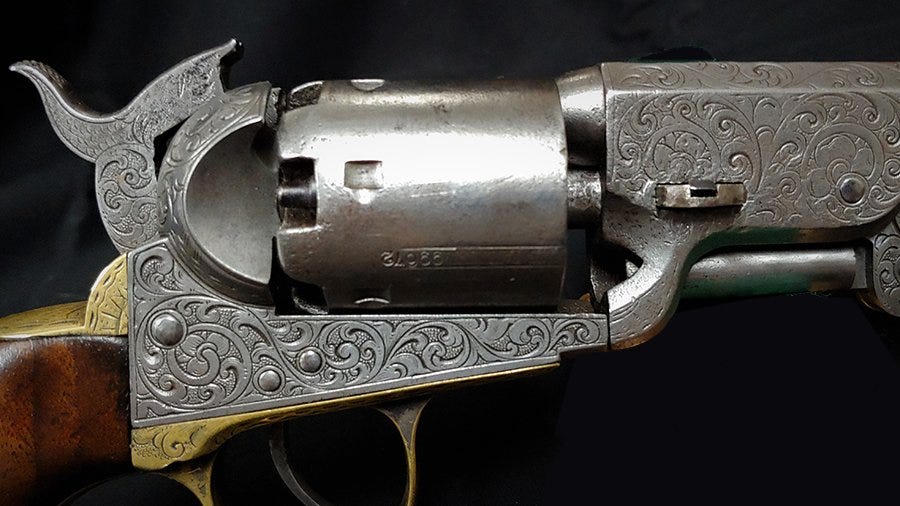
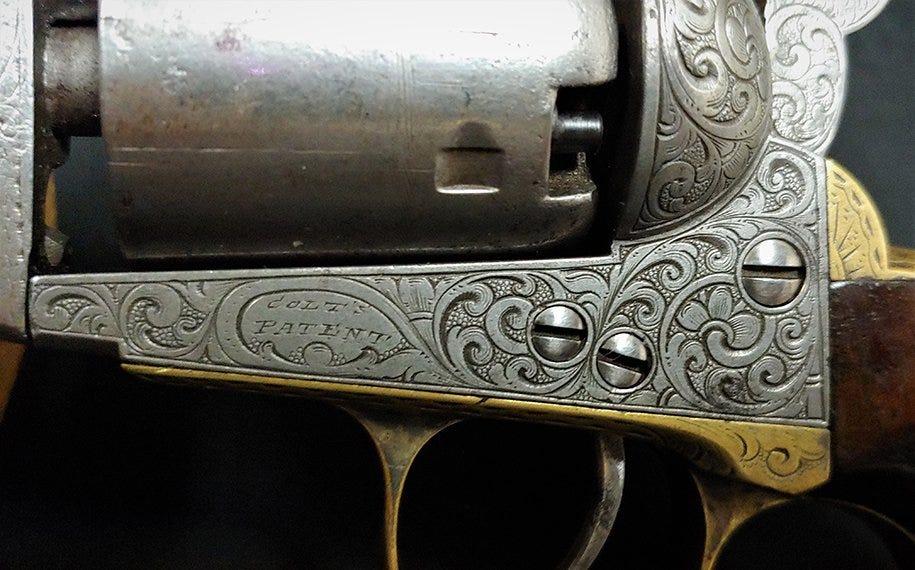

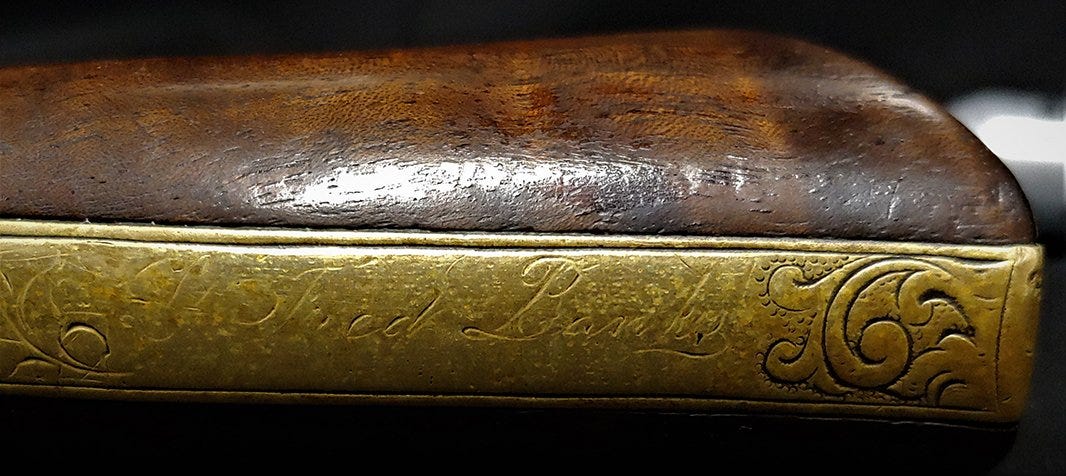
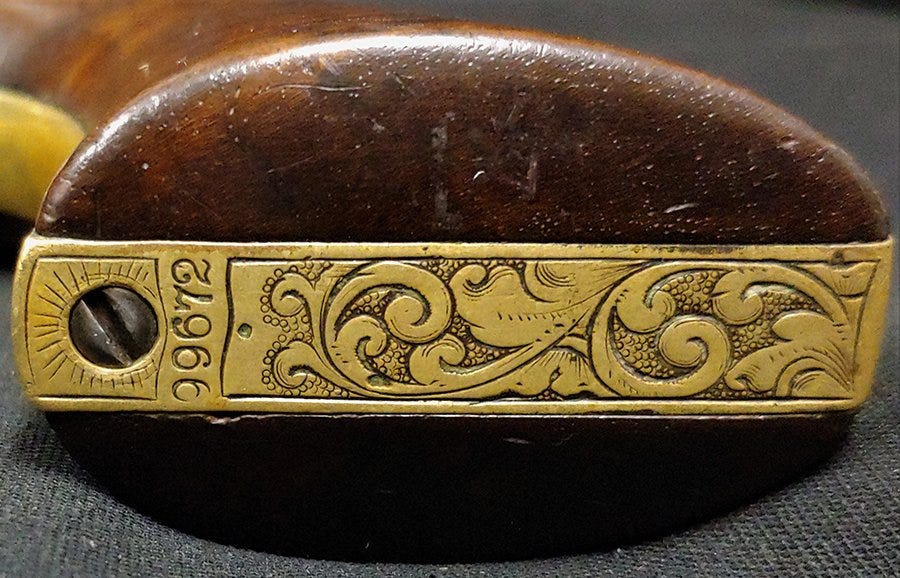

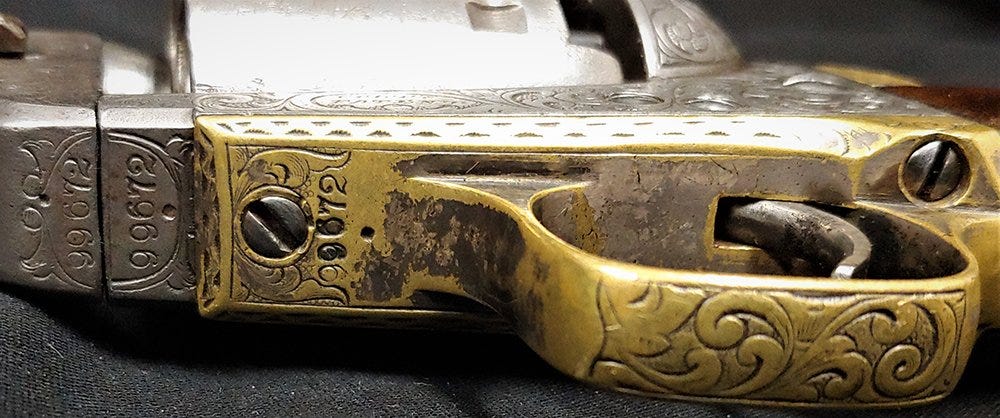
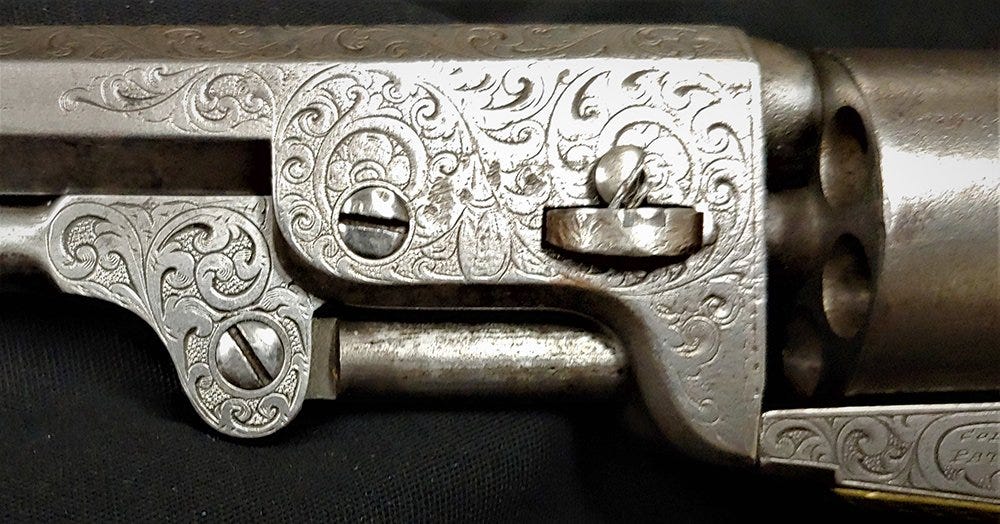
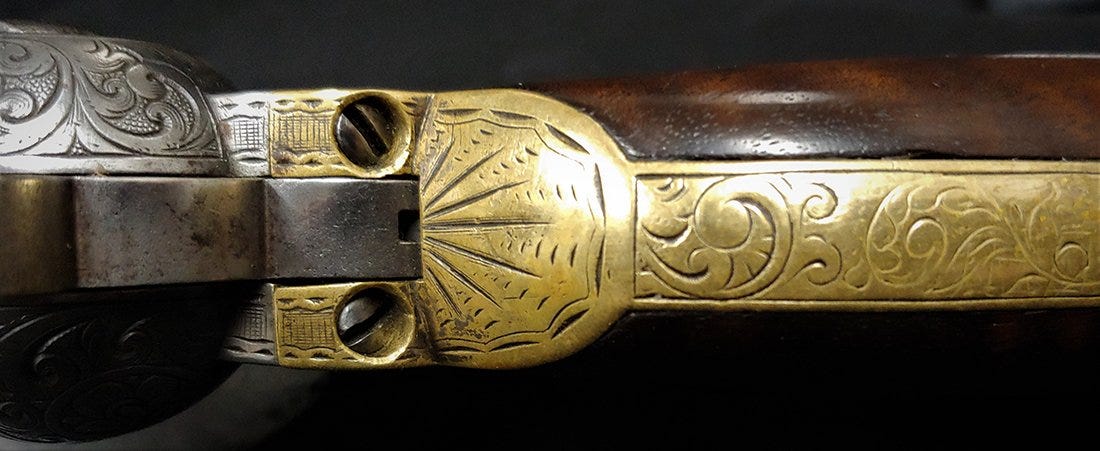
==============================
UNIQUE – ONLY ONE IN EXISTENCE – PATTERN
SWORD SUBMITTED TO THE U.S. ARMY FOR
CONSIDERATION BY W. CLAUBERG IN 1862

21-09-06 Beyond rare, this sword is truly and literally unique. This is the only one of this pattern in existence inscribed by Clauberg. It has been in my personal collection for over forty years.
This heavy horseman’s saber is deeply and professionally engraved “W. Clauberg Solingen Pattern Presented to the United States May 1862”
Wilhelm Clauberg was a sword maker and steel manufacturer in the Gasstrasse in Solingen, Prussia. His firm supplied edged weapons to most of the civilized world throughout the 19th century. The firm’s origins date back to around 1810. The numbers of swords Clauberg supplied to the Union Army is incalculable. Surviving specimens would seem to indicate that Clauberg was likely the most prolific supplier from Solingen.
My belief is that this model sword was an obsolete Prussian pattern and that Clauberg had access to many thousands of them. Being inexpensive surplus weapons, Clauberg was hoping to cash-in by selling thousands to the US Army for cavalry use.
Since this pattern is not known to have been issued to US troops, we can surmise that the Ordnance Department did not approve this pattern. This sword surfaced in Detroit forty years ago. It is one of my favorite finds and is an important piece of Civil War history. I would love this to find a new good home… but I am just as happy to keep it on my collection-room wall.
$3,500.00
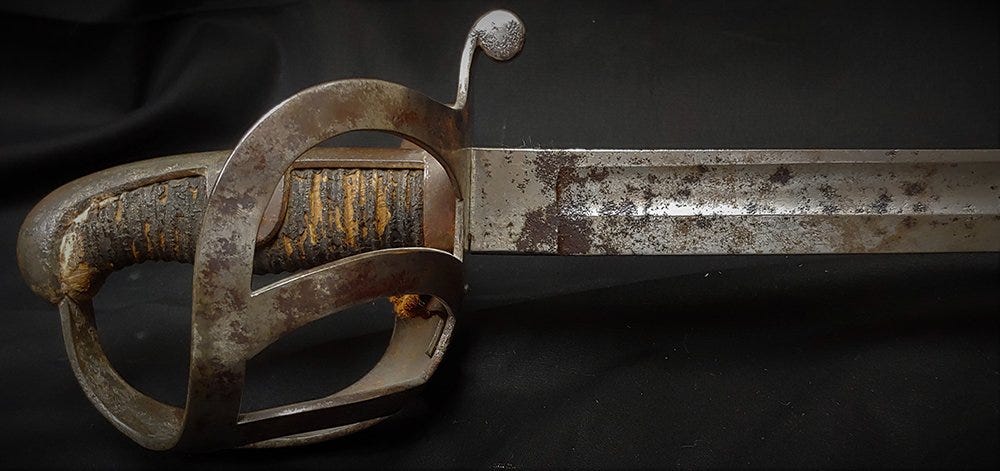
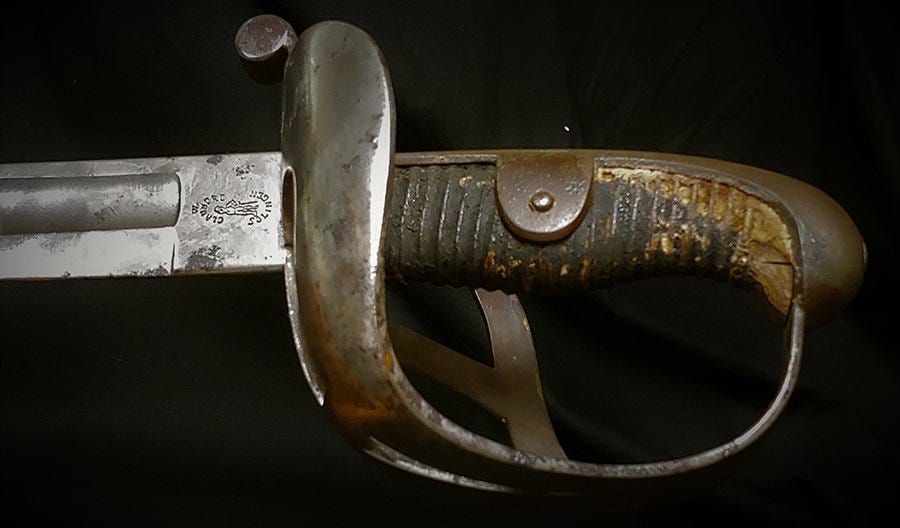



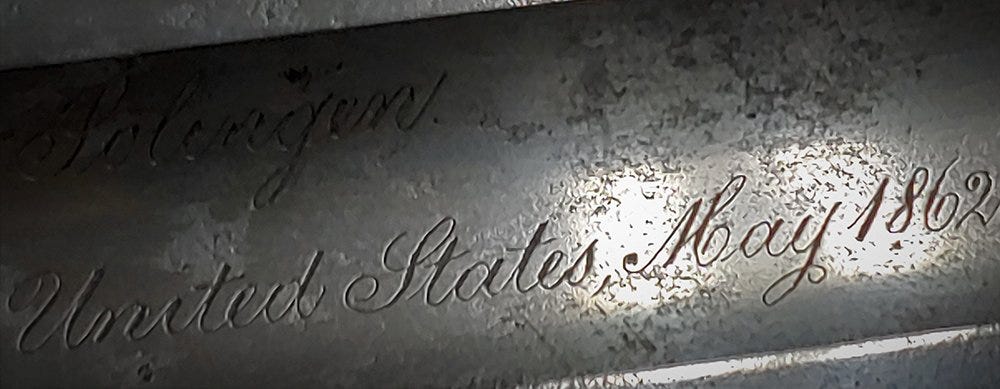
=============================
4th Mass. Cavalry Officer’s Kepi

21-09-02 Absolutely untouched and dead-real Civil War officer’s cap of the 4th Regiment Massachusetts Volunteer Cavalry made by Schuyler Hartley & Graham New York. Overall good condition with serious wear to the quilted lining, and a large moth hole on the right side. The silk lining inside the crown still shows the embossed maker’s marking of Schuyler Hartley and Graham. That’s about as good as it gets. The wool is gently faded with some brown toning. 100% complete and 100% original. The cap tells it’s own story. Front has bullion embroidered crossed sabers and numeral 4. The side buttons are Mass State Militia buttons. The only thing we don’t know is the owner’s name.
The 4th Mass. Cav. is an interesting and unusual unit that actually saw battle action in Florida at the battle of Olustee. Florida regiments are rare.
The regiment was organized on Feb. 12, 1864 and carried on its rolls a total of 88 officers and 1,621 enlisted men. Its losses during service were 4 officers and 22 enlisted men killed or died of wounds; 1 officer and 92 enlisted men died by accident or disease; 1 officer and 24 enlisted men as prisoners. In February some of the regiment participated in the Expedition from Jacksonville, Fla., to Lake City, Fla., then February 7–22, 1864 The Battle of Olustee, Fla. On June 6, two companies under Capt. Morton moved to Jacksonville, Fla., and encamped there. In the early part of August the detachment formed part of an expedition up the St. John’s river to Palatka, engaging the enemy at Palatka, Magnolia and Gainesville, with a loss during the expedition of 6 killed and 50 captured, including 3 officers. On Oct. 17, Maj. Keith having resigned, Capt. Webster was promoted to the position. A detachment, under Capt. Staples, took part in an expedition to St. John’s island, S. C., in July, suffering a small loss in the various skirmishes from the 2nd to the 9th. The battalion remained stationed at Hilton Head and Jacksonville by detachments until the close of the war. On reaching Hilton Head, the 3rd battalion was ordered to Fortress Monroe, and reported to Gen. Butler, encamping at Newport News until May 23. It then moved to City Point, Va., and there established headquarters. The 1st battalion, under command of Capt. Richmond, arrived from the south on May 8, and participated in the movements of the Army of the James during the rest of May. In June the command took part in the cavalry operations against Petersburg, being in action at Drewry’s bluff and Bermuda Hundred. Cos. E and H were on detached duty in June, at the headquarters of the 18th corps. On Aug. 15, the 1st and 3rd battalions, under command of Col. Rand, became a part of the 1Oth corps and took part in the operations before Petersburg. They were so engaged until the opening of the spring campaign in 1865. Meanwhile four companies had been detached for service with the 24th and 25th corps, remaining on this detail until their muster out. Cos. E and H with the 25th corps were the first troops to enter Richmond when it was evacuated on the morning of April 3rd. Cos. I, L and M under Col. Washburn were at the headquarters of the Army of the James’ commanded by Gen. Ord. On April 6, 1865, this little force of 13 officers and 67 men were almost annihilated in the effort to hold High bridge over the Appomattox, where in three desperate charges against overwhelming odds, 8 of the officers were killed or wounded, among the mortally wounded being the gallant Col. Washburn. After the surrender of Gen. Lee, all the detachments of the regiment were united at Richmond and remained there on duty during the summer and autumn. On Nov. 14, 1865, the regiment was mustered out and the same month returned to Boston, the men being paid and finally discharged at Galloupe’s island on the 26th.
A dead real and 100% honest cavalry kepi. $3,250.00
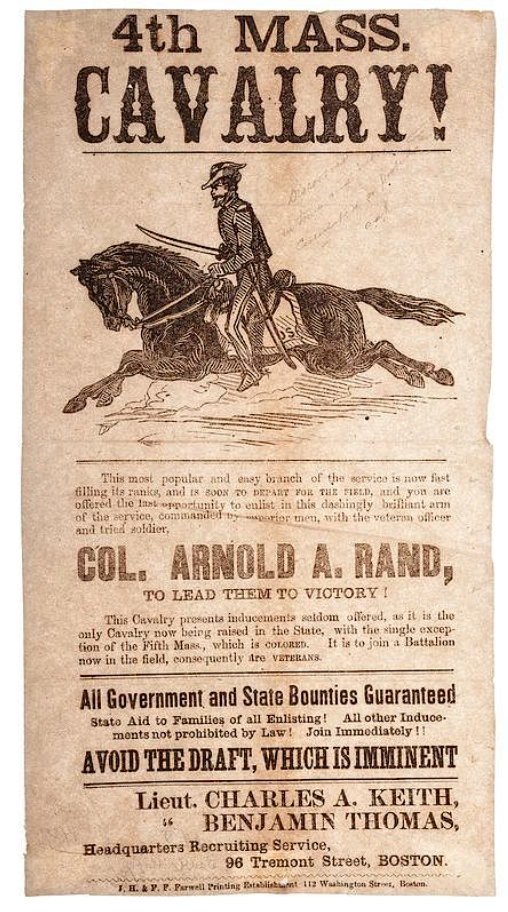
Recruiting poster shown as illustration Clip-Art only.

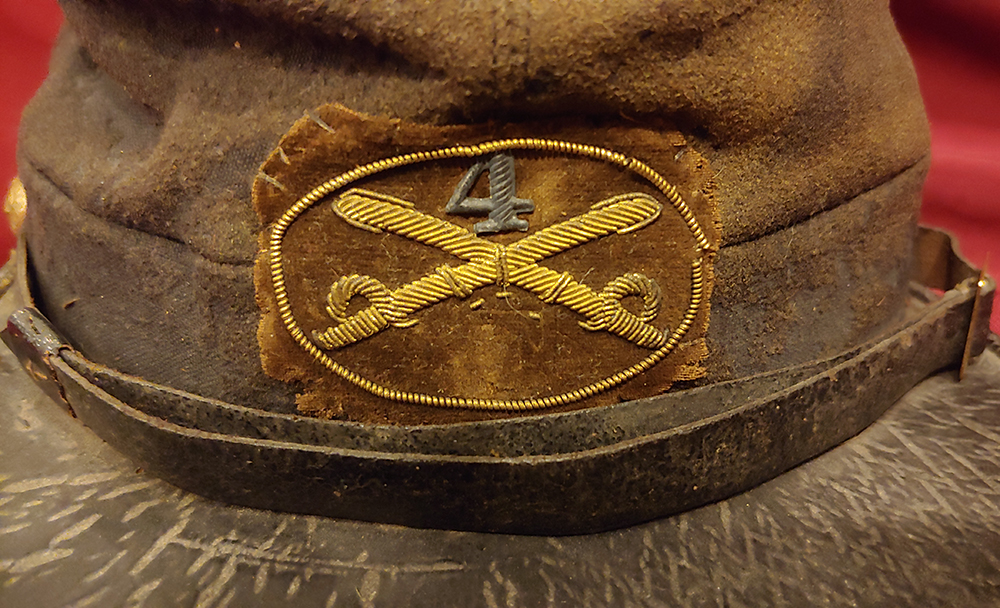
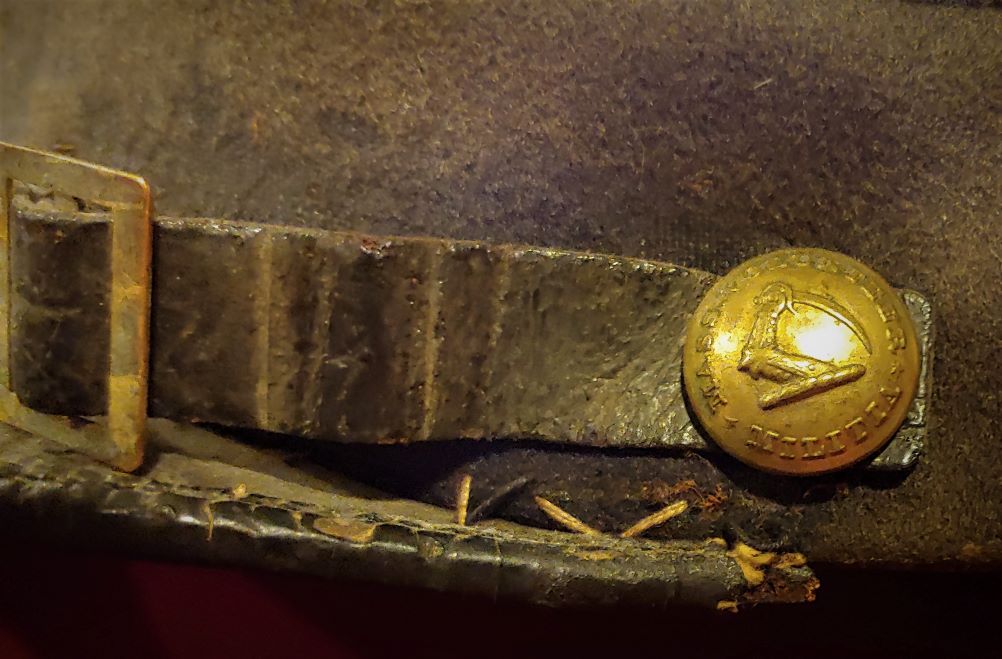
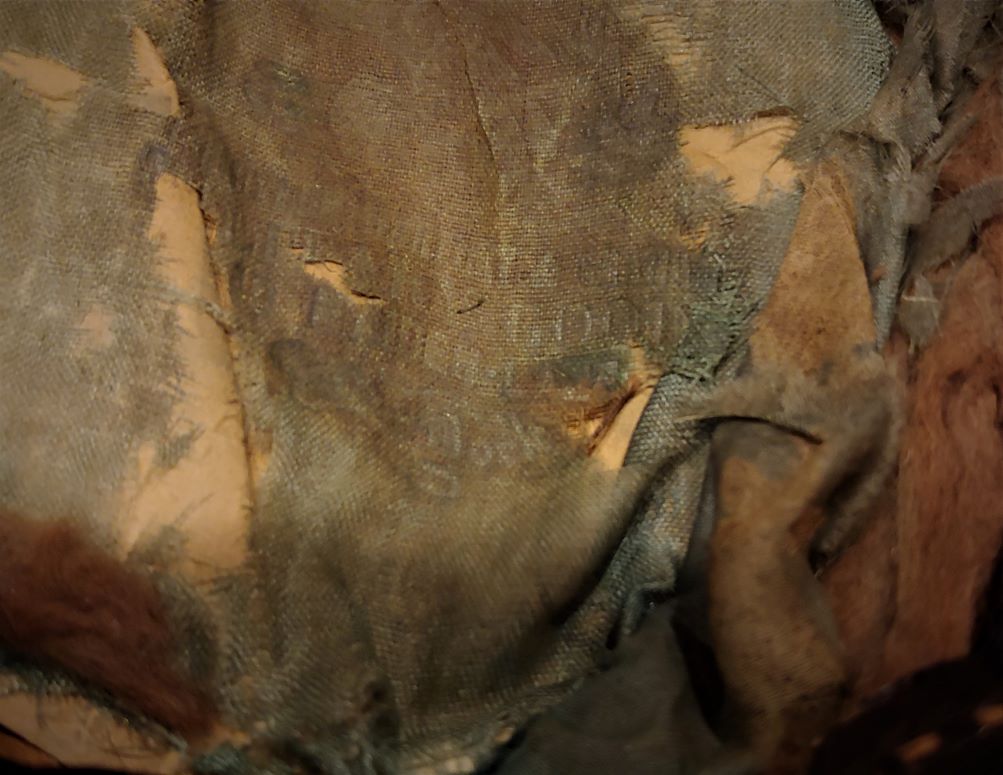



=============================

13-09-48 … Silk New York Artillery Civil War Battle Carried Flag… 28″ x 29″ flag matted in a 38″ x 40″ frame. One of the great rarities in Civil War collecting are the silk flags, markers, guidons, and colors that were actually flown in battle. This is the actual marker flag of The 2nd NY State Volunteer Artillery which served as infantry in the 2nd Corps during Grants 1864 overland campaign against Lee. This is the real deal … The original silk flank marker of the New York Second Heavy Artillery presented by the City of New York as part of a stand of colors when the regiment reenlisted as veterans. Boldly painted in crimson-shadowed gilt letters: N.Y.S.V.V. ARTILLERY for the New York State Veteran Volunteer Artillery, with the regimental number 2d on red in a central cartouche with gilt rococo border with flourishes. Narrow blue sleeve for rod-mounting on a staff as is correct, gold edge fringe intact. The matching companion marker, (two were included as part of the presentation stand of colors), is in the New York State Military Museum. These flank markers were carried by sergeants acting as the right and left general guides when the regiment formed in line of battle. See Howard Madaus’s multi-part series, Camp Colors, General Guide Flags and Flank Markers in the United States Army, 1861-1865 – Journal of the Company of Military Historians – part 3, pages 156-157. This example is among the most visual of all surviving markers as it is painted with full unit I.D. instead of just a simple numeral. It is professionally conserved with just some minor silk loss and loosening of the gold fringe border at the bottom right, mounted with some blue silk in the background and red at the center where the missing lower portion of the 2 and part of the period and the d have been professionally in painted. This was done wonderfully well. See the close-up photos I have provided. The losses are minor and this is a splendid looking flag worthy of the best collection. The Second NYHA was a hard-fought unit. Stationed in the forts around Washington and Alexandria early in the war, it was then called into the field in the Spring of 1864 to serve as infantry and assigned to Tyler’s Artillery Division of the 2nd Corps, which was actually just a brigade, but was of division strength due to the full rosters of the heavily manned artillery regiments brought into its folds. It was quickly thrown into some of the worst fighting of the war. At Spotsylvania the regiment lost 117 men; at the North Anna, 95; at Cold Harbor, 215; at the assault on Petersburg and the Weldon Railroad, more than 350, and the list goes on Deep Bottom, Strawberry Plains, Reams Station, the siege and fall of Petersburg, the Appomattox Campaign. In battle deaths alone the regiment the regiment lost 10 officers and 206 men, and more than 600 who were wounded and recovered. Their total of killed, wounded and missing was a staggering 1,140, the vast majority in the last bloody year of the war. Of some note is that a horrible fake version of this flag constructed of coarse material, came on the market several months ago through a major auction house. It was cataloged and sold as real, despite looking completely bogus in the on-line photos. The counterfeit flag was subsequently returned by the buyer and resold, this time being properly described as being from a later period. Whether that flag was made for reenactors or meant to deceive, I cannot say. I can say, however, that the one here offered is absolutely genuine and original and is one of the original pair of markers presented by the City of NY when the regiment veteranized. The veteran designation coming after a sufficient number of men reenlisted to keep the regiment in service and retain its designation (late 1863 to early 1864). A top notch flag, very displayable size, great color and visual appeal, and from a real fighting regiment. They don’t get much better and I’m sure the new owner will enjoy looking at it on his wall as much as I have One of my favorite pieces … $24,500.00 SOLD

13-09-35 – 34 Star Flag … Measuring approximately 62″ x 65″ … This is a Very Rare and Very Important Southern Sympathizer Union Flag … likely a Vallandingham Democratic Party Copperhead Flag!
Very striking 34-star US flag with wonderful color and complex star pattern- a mix of wreath and spiral pattern with one large central five pointed star and thirty-three others circling and floating around it. Vertical canton extending seven stripes down. The white sixth stripe bearing the inscription in red: “The Union as our Fathers m[ade it]” the very right portion of the motto and fly-end of the flag missing, but neatly bordered to preserve it. Minor staining to the white stripes here and there, some small runs along the top and bottom of the third stripe near the fly with minor loss on the bottom edge of the first, all near the fly end. Fabric solid and very displayable.
Northern opponents of Lincoln and government war policy had a big problem: how to oppose it and yet appear loyal. Clement Vallandingham, Democratic Congressman from Ohio became the leader of the faction, termed by opponents “Copperheads,” and was known for his support of states rights and secession, opposition to abolition and equal rights, and votes against every military appropriations bill that came before him. Vallandingham thought he had found a solution to the dilemma of how to proceed in public by blaming abolition for the crisis and claiming to be loyal to the original intent of the Constitution and Union. A good example of Vallandingham’s public tactics was his New York speech of Dec. 12, 1862, reported the next day in the Times, which incorporated the very motto on this flag:
“If the Constitution be destroyed the Union perishes with it. [Cries of “Good,” “good,” and applause.] I mean the Union as it was — [applause] — the Union as our fathers made it — [applause] — the Union of Washington — of Madison — of John Jay and Alexander Hamilton, [applause,] which gave us peace, prosperity, happiness, grandeur, glory and greatness, such as never belonged to another people since creation’s dawn. [Applause.] The Union, which now is proclaimed to “the Union as it ought to be” -the man who attempts such a Union — a Union different from what descended to us, and all those blessings which our fathers gave us — the man who attempts such a Union, by whatsoever name he may be called, is a traitor. [“Bravo,” and cheers.] Not for any such Union, it is the unity of despotism, not the unity of fraternal affection, or of independent and sovereign States which legislated for themselves. It would be a Union without freedom of the Press, without freedom of speech, without freedom from arrest, without freedom from search — unwarrantable, unreasonable and unconstitutional — without any of the guarantors which a free people have ever demanded; such is the Union which the Abolitionists of this land would set up for the American people, and which they proclaim is the Union as it ought to be. [Applause.] Not such as our fathers made — not such as in 1787 they established and consolidated for the protection and defense of the liberty of the white race of the United States. [Applause.] That Union I am ready to defend.”
Earlier the motto was used by Virginia before she seceded. In February 1861 The Weston (Virginia) Herald editorialized the following in regards to whether Virginia should secede… “…she (Virginia) will unquestionably take her position with the seceding States. That such a dread alternative may be avoided is the ardent wish and prayer of every patriot in the land. We love and venerate the Union of these States—the Union as our fathers made it—the Union with the Constitution—a Union that guarantees equal rights to all the States—a Union whose compromises and whose Constitution will be faithfully and fully carried out by all the parties.
“… Needless to say, the motto “The Union as our Fathers Made It” is unequivocally a pro slavery, pro states rights, sentiment. Vallandingham’s adoption of it in his speech are telling but his efforts did not exactly succeed. He was later arrested for a “habit of declaring sympathies for the enemy” in violation of an order issued in the Military Department of Ohio and eventually expelled to Confederate lines, from where he made his way to Canada and eventually back into the U.S. to run an unsuccessful campaign for Governor of Ohio and take part in McClellan’s 1864 run for the Presidency.
Pro-Union and Pro-Lincoln flags are absolutely common by comparison to those of his northern opponents. There were fewer made to begin with and not many were preserved afterward. Nobody wanted to be reminded they were on the losing side and after the war very few would acknowledge opposition to the martyred President. Whether the last few inches of the fly end of this flag are missing from wear or were intentionally removed to conceal its origin or by a political opponent I can’t say, but it is a striking Stars and Stripes even with that damage and it is a very rare piece of Civil War political history. … $16,500.00 SOLD
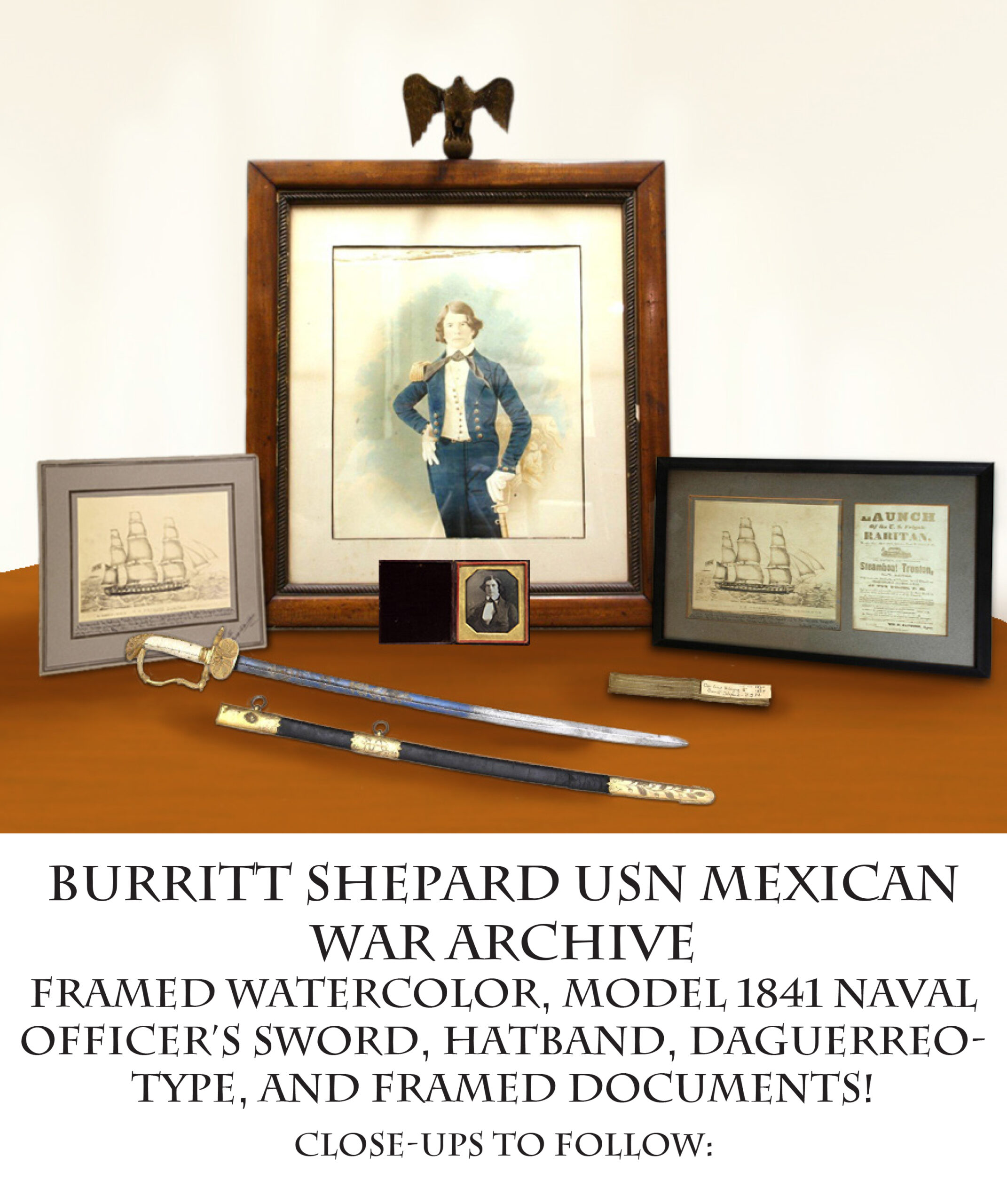
12-09-17 – Wonderful Mexican War US Navy Officer’s Group including his sword, daguerreotype, and portrait with the very sword! Fresh from the family! This super group also has his hat band, portraits of his ship and even a handbill for its launching, all preserved and documented by his son and passed down to his great-grandson.
Burritt Shepard was a member of an old and well connected family. I was fortunate to have a colleague contact me when he found this archive in a Virginia antique shop. We bought it instantly. Shepard enlisted in the navy and became a Midshipman 1 Feb. 1826; made Passed Midshipman 28 April 1832; and Lieutenant 8 March 1837; he resigned 22 June 1849. During his service he was on board the USS Lexington in the Mediterranean as a Midshipman and his journal from 1827-30 is preserved in Rutgers University library. In the early 1840s he was assigned to the newly launched USS Raritan and acted as Executive Officer during that ship’s participation in the blockade and landings on the Mexican coast during the war. He resigned in 1849 and raised a family. His grandson retained these mementos of his service and passed them on to the great grandson about 1920.
The object of greatest interest will be Shepard’s model 1841 US Navy Officer’s Sword. Regarded by many as the most beautiful of US regulation swords, this example has loads of original gilt on the hilt, still has its scabbard in very good condition, and bears a dead-real commemorative inscription on the inboard folding guard reading:
Lieutenant Burritt Shepard
U.S. Navy
Midshipman, 1826 Lieutenant, 1837
Resigned 1849 Executive Officer
Frigate “Raritan”
In Mexican War
When found there was a break and slight loss in the scabbard just above the drag. I had this professionally restored using a two inch section of identical original scabbard material. The repair is virtually undetectable.
Also present in this lot is a wonderful large portrait of Shepard in uniform holding this very sword!
Sword: The eagle head pommel, backstrap, and knucklebow retains loads of the original gilding, as do the acorn shaped quillons and the outboard fold down guard with the leaf and acorn design. The bone grip shows a bit of age shrinkage from the backstap and a longitudinal crack on either side near the bottom edge, but is solid. The half-blued blade is flat backed (these were produced both quill back and flat back) with much of the original blue which shows off the beautiful gilt floral designs: blade is etched with fouled anchor, circle of stars oak leaves and acorns. The blue has shaded into a charcoal tone where the maker’s name is dry etched at the ricasso: On the other side the blue is vivid, with some brown spots showing through.
The scabbard is excellent with the repair mentioned above. Lots of gilt remaining on the mounts: the upper mount with decorated stud as well as carrying ring, floral decorations and a circle of stars, fouled anchor on the middle mount with carrying ring, and drag bears leaves and acorns.
The sword is clearly shown in the uniformed portrait of Shepard. The large portrait is a delicate pastel work showing Shepard standing ¾ length, knees up, with this very sword clearly shown. The frame measures 31” x 28”. Typical 1840 hair style and big flowing necktie. Posed in his short blue cutaway double-breasted jacket with brass buttons on the front and horizontally across the cuff, with correct single epaulet of a Lieutenant, all proper for the undress uniform of 1841. He has white gloves, one off and held at his side while the other hand is gloved and resting on the pommel of this sword. The oak frame on this appears to date circa 1890. There is a very cool eagle on globe fixed to the top center of the frame. This looks dynamite displayed with the sword! Present is a fine sixth plate daguerreotype of Shepard that seems to have been taken about the same time as the original photo on which the portrait was based. The hairstyle looks the same and he wears the same outlandish bowtie. His coat seems also to be an undress jacket, though the end of the necktie flares out so that it not possible to see if he is wearing the epaulet. The Shepard family also preserved for us the 1841 regulation bullion band from his undress hat with a very nice, clear, period brown ink note pinned to it reading: “Cap–band belonging to Burritt Shepard – U.S.N. 1826 to 1849.”
Two images of the USS Raritan were also kept with the group. The first is a copy photo made by a Somerville, NJ, photographer of a lithograph made soon after the launching of the ship, showing it under sail and giving its date of launch, tonnage, armament, etc. This was inscribed by Burritt Shepard’s son when he passed the material to his grandson: “Presented by Robert Fitch Shepard to his grandson Robert Fitch Shepard Whitely, whose great grandfather, Lieutenant Burritt Shepard, U.S. Navy, was Executive office of the Raritan in the War with Mexico.”
Another copy of the same image was also framed together with a Victorian photographic copy of an earlier handbill advertising an excursion aboard the steamboat Trenton to witness the launch of the Frigate Raritan the next day. It gives times of departure, etc., and notes that they will take up a “favorable position near the Navy Yard, to afford to those on board a full view of the Launch.”
The USS Raritan was launched until 1843, one of the last sailing frigates of the US Navy. In 1844-45 the ship was in the South Atlantic, and then made part of the Home Squadron. Based in Florida, the ship helped blockade the Mexican coast and participate in landings at Point Isabel, Veracruz, Tuxpan, and Tabasco. The ship then returned to the Norfolk Navy Yard and was laid up briefly. After Shepard’s departure the ship was in the West Indies and eventually the Pacific. Having returned to Norfolk and being again laid up, the ship was destroyed at the beginning of the Civil War when Union forces had to evacuate Norfolk in 1861.
This is an outstanding American family archive, to have it is to be part of American history. I am proud to offer it, and you would be proud to have it on the wall…. SOLD
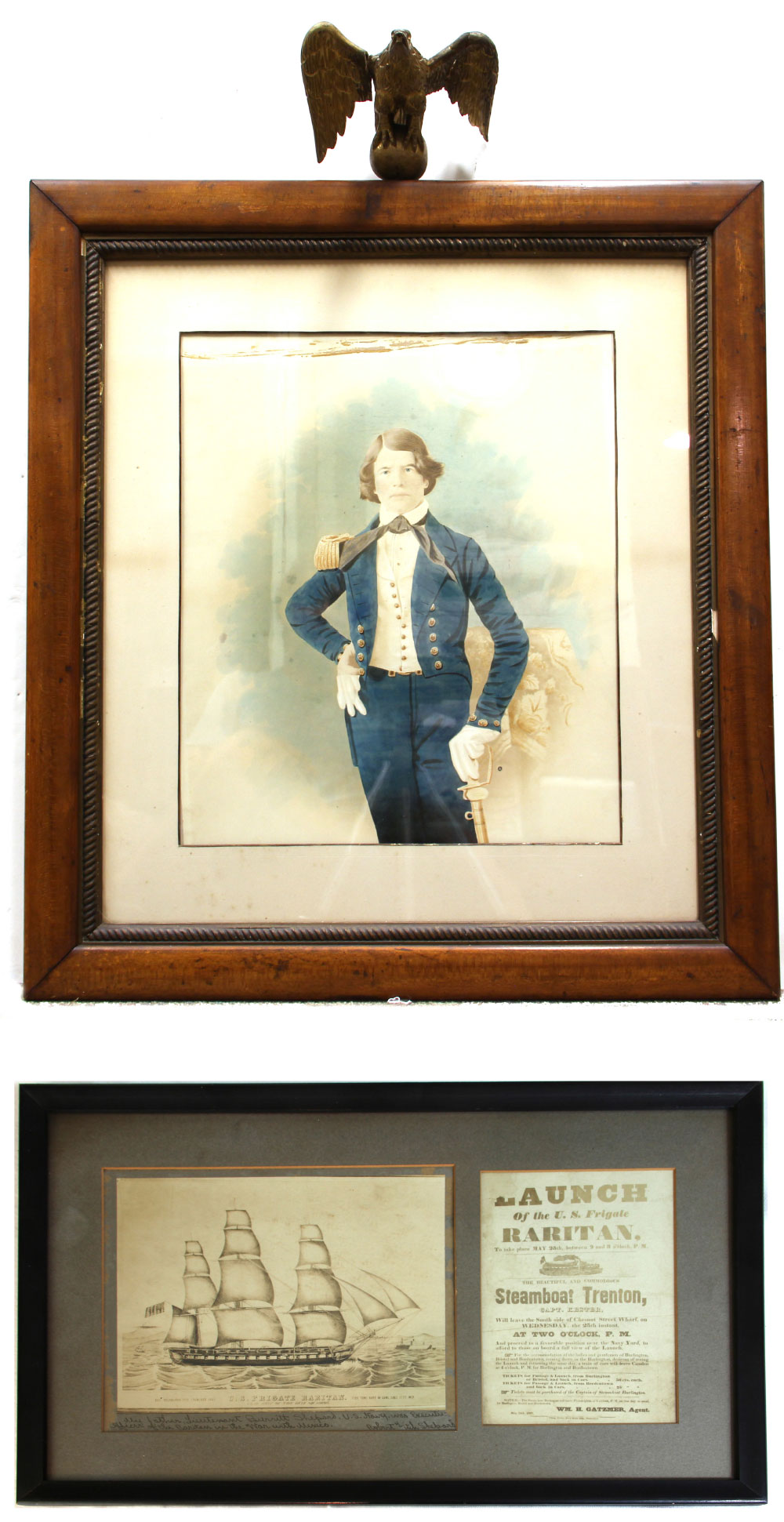
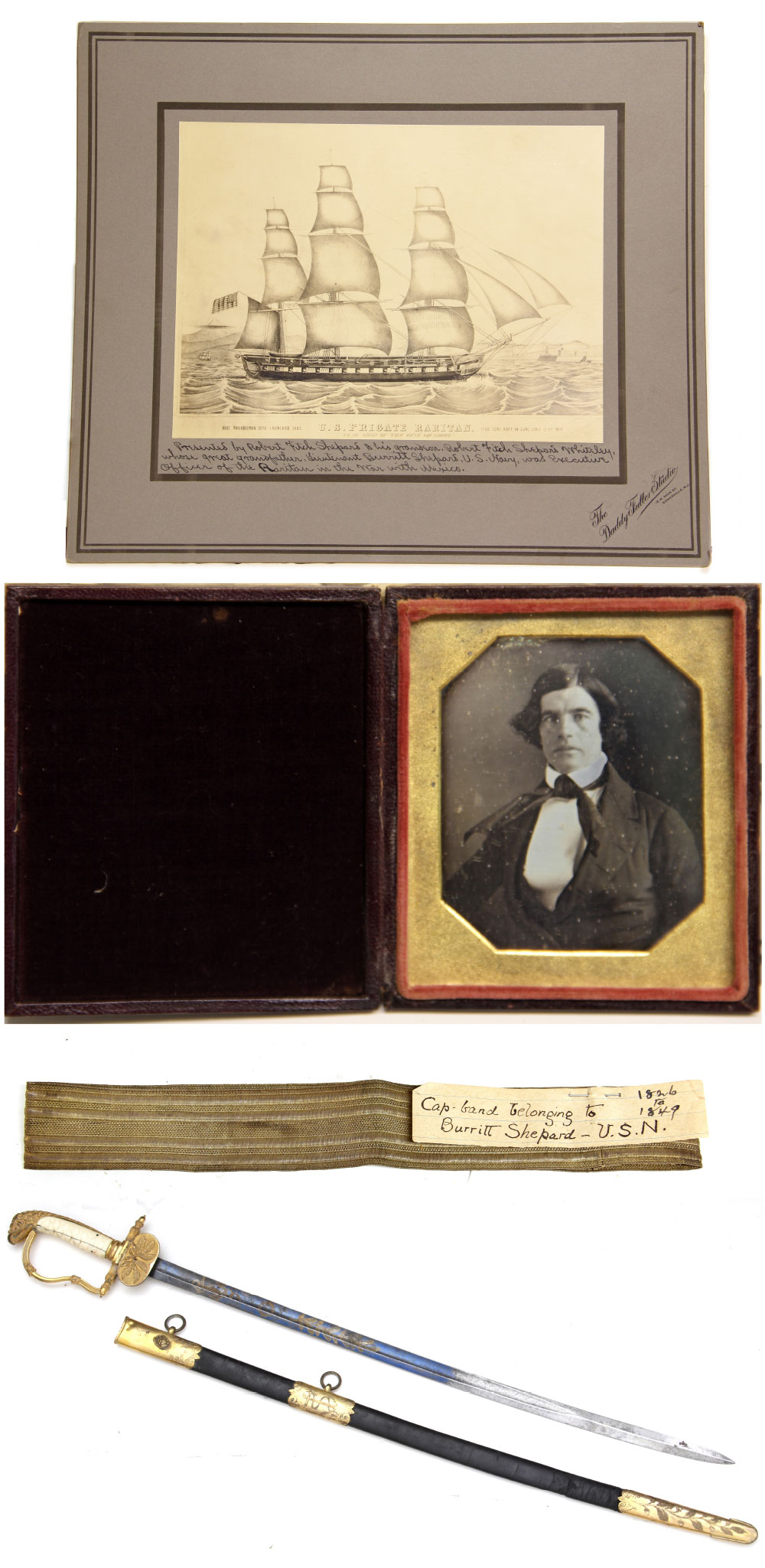
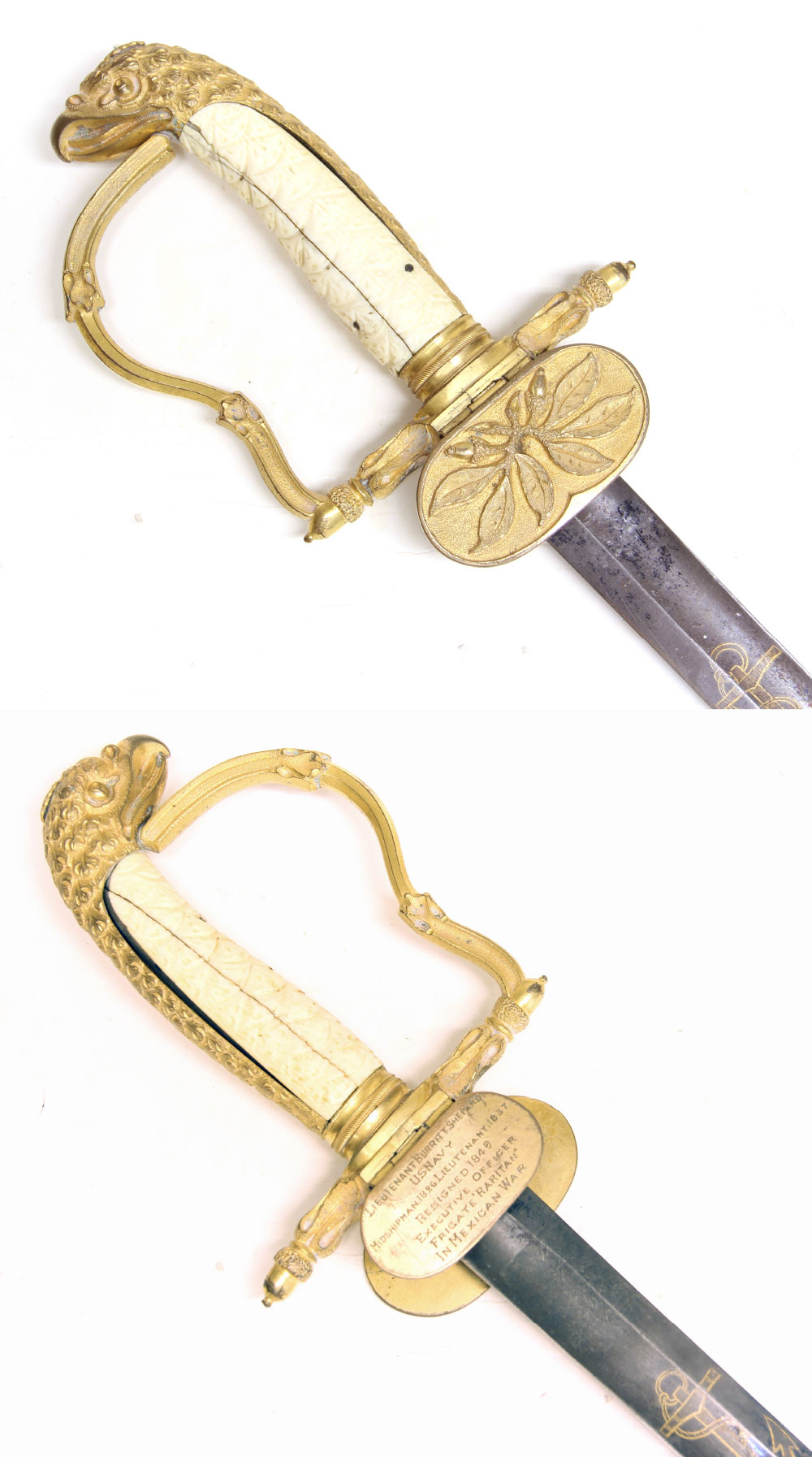
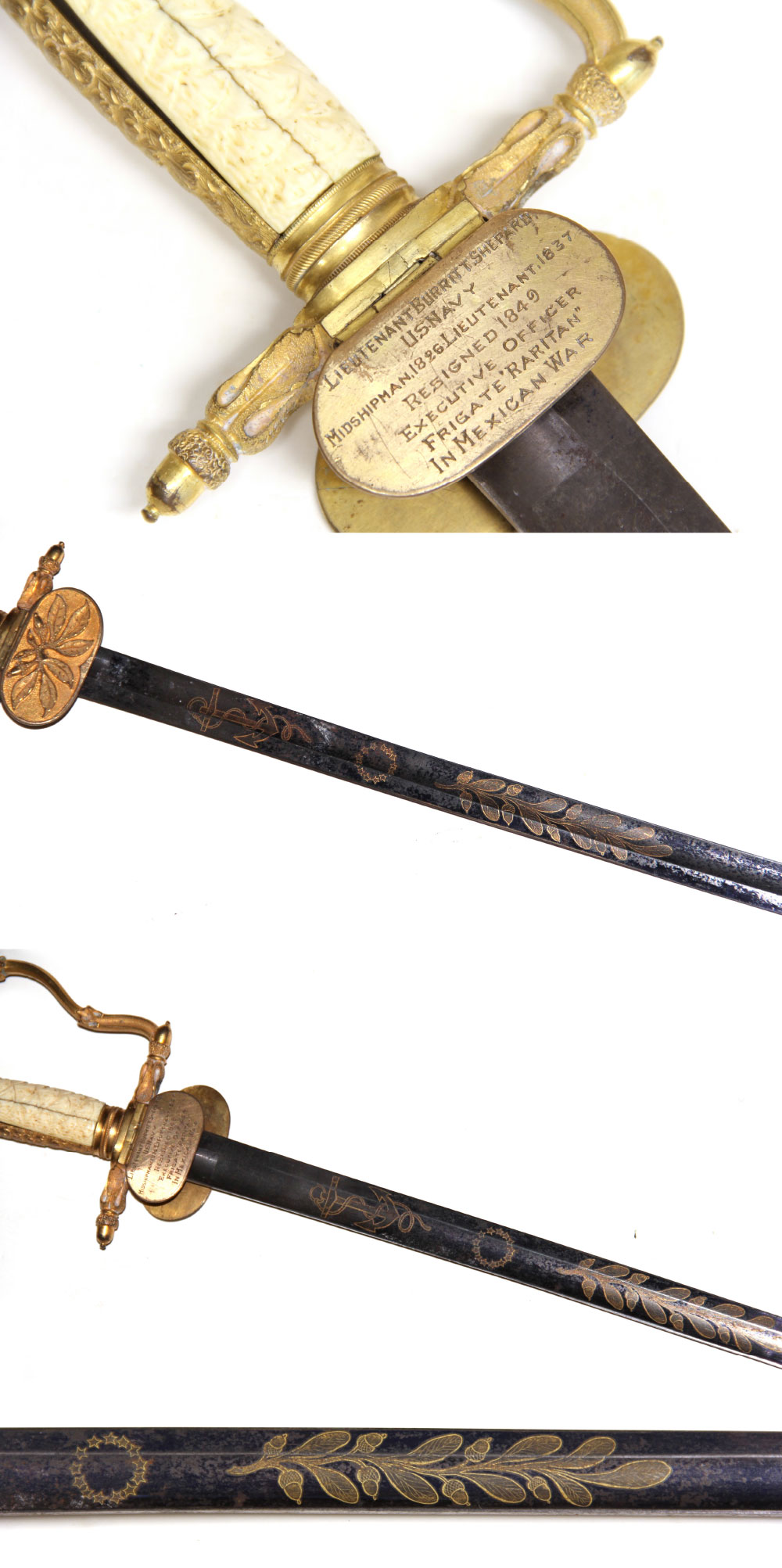
$8,900.00

#068 – Presentation Engraved War Date 1860 Staff Officer’s Sword Presented to Surgeon: – This is the 1860 staff officers sword which is virtually impossible to find made pre 1865, a true rarity in military collectibles. This sword is etched with the US coat of arms, military trophies, and floral designs. The knuckle-bow has floral scrolls and thunderbolts, and the guard has an eagle and arms on one side, with the opposite hinged clam shell guard bearing a beautiful engraved inscription which reads “ Dr. Carr/from/Capt. Craig”. This sword is missing the small ball, which helps keep the counter-guard either open or closed, but other than that is complete. I had helper Tom install a cosmetic “ball” for display purposes. The condition is “very good” The brass mounted steel scabbard is likewise “VG” showing just the right amount of age. The patina on the brass is rich, deep, undisturbed, and beautiful… the way you wish all your antique brass looked. As for our good Dr. and his friend Capt. Craig, I have found a handful of surgeons named Carr and a few Union Army captains named Craig. None of the possibles served in the same unit, so we will surmise that their relationship was professional with the gifted sword possibly for medical services rendered. I will leave the research project of determining which Dr. Carr and which Capt. Craig have the “doctor – patient” relationship. I am certain the relationship can be discovered but am equally certain that it will take a lot of hours of detective work to find it, hours that I do not have to spare at this end. …An extremely scarce sword with a compelling and tantalizing inscription begging for research… a very fair deal at $1995.00 SOLD

#120 – Presentation 38th Pennsylvania Officer’s Sword – SHOT IN THE LEG (by himself): Ames Foot Officer’s Sword w/ great presentation – Engraved on the top mount “Presented to / Lieut J. Wills / by / Stephen Mercer / Andrew N Kennedy / and others / June 1861”. This is John Wills 38th PVI. The sword itself is in very good condition save for a few nicks in the blade. The scabbard has lots of weak spots and bends, but is not broken through. The grip is VG+ with the original twisted wire wrap. The brass guard has a slight bend in it near the quillon. The blade is signed with the scroll style Ames marking, and the scabbard is marked on the throat “AMES MFG. CO. CHICOPEE MASS”. The brass mounts have a smooth light patina and are in VG shape, the drag is slightly dented, but nothing too serious. Mills served from May 1861 through August 1862. During the period the 38th PVI saw battle at Dranesville, VA, Mechanicsville, Gaines Mill, and Glendale. He accidently shot himself in the leg in the fall of ’61. An interesting Civil War presentation sword that is very affordable. $2,450.00 SOLD

#175 – Exquisitely Engraved Presentation Foot Officer’s Sword – One of the prettiest and lengthy inscriptions I have seen. On the throat mount, “David T Johnson / of / Ansonia Conn / Captain Co. F. 23rd Regt.” and on the middle mount … “US Service / Nov. 14 1862 to Aug. 31 1863” This sword has a superb, nearly new 30 1/2 inch blade, a Very Good guard, with a small bend, original wire, and good leather. The scabbard has the engraved presentation on the two brass ring mounts and we have repaired the leather about 3 inches from the drag where the leather had separated. There are pleasing flourishes and adornments with the engraving that really set this apart from most other presentation work we see. Captain Johnson and his men in Company F under command of Major Miller were held in New York until December 30th 1862, when they embarked on the ship “Planter” for the south. It was wrecked January 14, 1863, on Stranger’s Key, Bahama Islands. After obtaining assistance from Nassau, this detachment finally arrived at New Orleans March 4th 1863. They saw action at La Fourche Crossing, Brashear City, and Bayou Boeuf, La. taking numerous battle casualties. Their service in the defenses of New Orleans was noble and effective and this is a truly wonderful and attractive Civil War combat officer’s sword. You will be well pleased at $3,250.00 SOLD
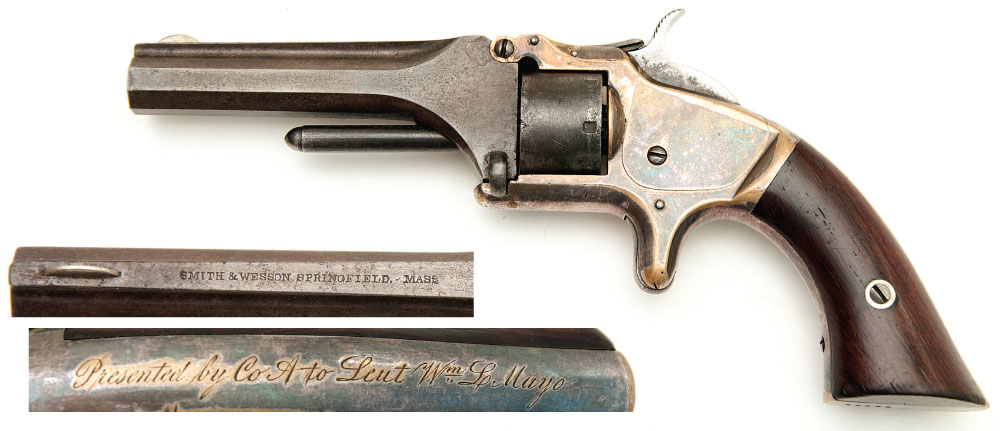
#200 – Presentation 100th New York Infantry Smith & Wesson No. 1 Revolver: – A fine Civil War small size 22 caliber Smith and Wesson personal defense weapon. SN 26503. This model is the 7 shot 22 caliber revolver with a 3 1/4 inch barrel. The barrel has hints of blue, and the brass frame has 80% of the silver finish (thinning). The rosewood grips are fine w/ minimal handling wear. The backstrap is engraved “Presented by Co A to Lieut. Wm L Mayo”. William Mayo has a really interesting Civil War service record. He was commissioned Lieutenant in Co. “A” 100th New York Vols where he served from Sept. 23rd 1861 through May 25th 1863. He was promoted to Captain Oct. 14th 1862, and commanded his company in the terrible Virginia Peninsular Campaign and through their fights in South Carolina. The 100th was initially assigned to Naglee’s 1st brigade, Casey’s 2nd division, 4th corps. It fought hard with McClellan, its losses at Fair Oaks being particularly severe with 176 killed, wounded and missing. Mayo is buried in Parke Cemetery, Wesley, Cattaraugus Co., in the southeastern part of the state. A superb presentation inscribed revolver in extra fine condition.. $2,650.00 SOLD
12-09-14 – Wonderful Folk Art Civil War Eagle Drum: Fresh from a family in California is this regulation Government Contract Union Army Eagle Drum with drum sticks affixed for display. Measures roughly 16 dia x 13 tall in size the bottom edge of the shell was shortened during its period of use to change the pitch. Excellent paint with no flaking and only minimal wear. The riband in the eagle’s mouth was over-painted, obscuring the regimental designation originally painted there. I presume this was done when the GAR post or museum added the drum sticks to it. The word INFANTRY can still be faintly seen on the viewer’s right hand side. Perhaps a competent art restorer could remove the over-paint and reveal the unit. Makes a superb display piece with the four drum sticks affixed to the rims forming a sort of table affair. Ropes are original but broken in places. No label remains. Very cool Civil War drum. Looks fabulous on display with other CW antiques as accents … $3,250.00 … SOLD
Soldier’s Money Belt, Housewife, Coin, and Relics with Family Tags: A wonderful lot of soldier personal items with intriguing hand written family notes. When I bought this all the items were mounted in a wall frame assembled in the mid 20th century mounted on non archival paper backing. I removed it from that inappropriate container. The grandchildren of the veteran wrote the notes stating that Grandpa Hiram Burlingame had been from Pennsylvania. The research I have done indicates that Hiram Burlingame was actually from Massachusetts. I find Hiram in the 46th Mass. with additional service in the 27th Mass. There are no other soldiers with that name shown on either the National Park Service web site nor the civil-war-data site. He is shown as Hiram J.R. Burlingame Jr. of Holyoke, Mass. — wounded in action at Cold Harbor. The housewife (sewing kit) is really great. Measures about a foot long when unrolled and obviously made by hand by a woman on the home front. The money belt is a high quality affair of fine red leather lined in a fine cotton or muslin. The inside has compartments for money and other valuables. The coin is an 1853 copper cent. The square nails were interesting to the family but not so much to me, and the little lead soldier likewise. A very honest and appealing lot of soldier items. $595.00 – SOLD
Layaways are Welcome
Need to split your order into multiple payments? No problem! A simple 20% earnest money deposit will hold your item for you.-acf
You can then pay it off in easy installments that fit your budget.
Read Terms Here
Items to Sell? Contact Us
I am always interested in buying ANYTHING from the American Civil War… Guns, Swords, Civil War Muskets, Knives, Uniforms, Flags, Medals, Badges, Diaries, Letters, Autographs, Buttons, photographs, tintypes, daguerreotypes, Insignia, Camp Items, Battlefield Relics, canteens, Drums, Etc… Call 419-842-1863 and ask for Dave Taylor.


